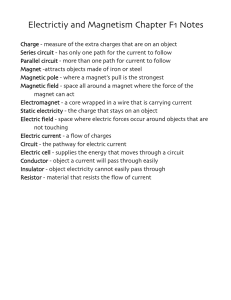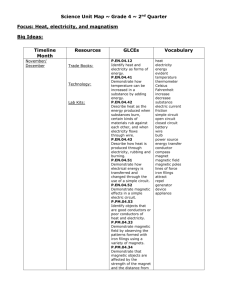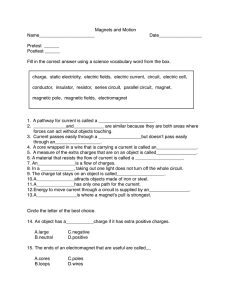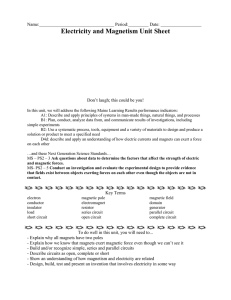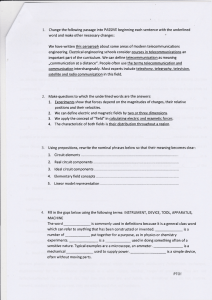Electricity - Blogs
advertisement
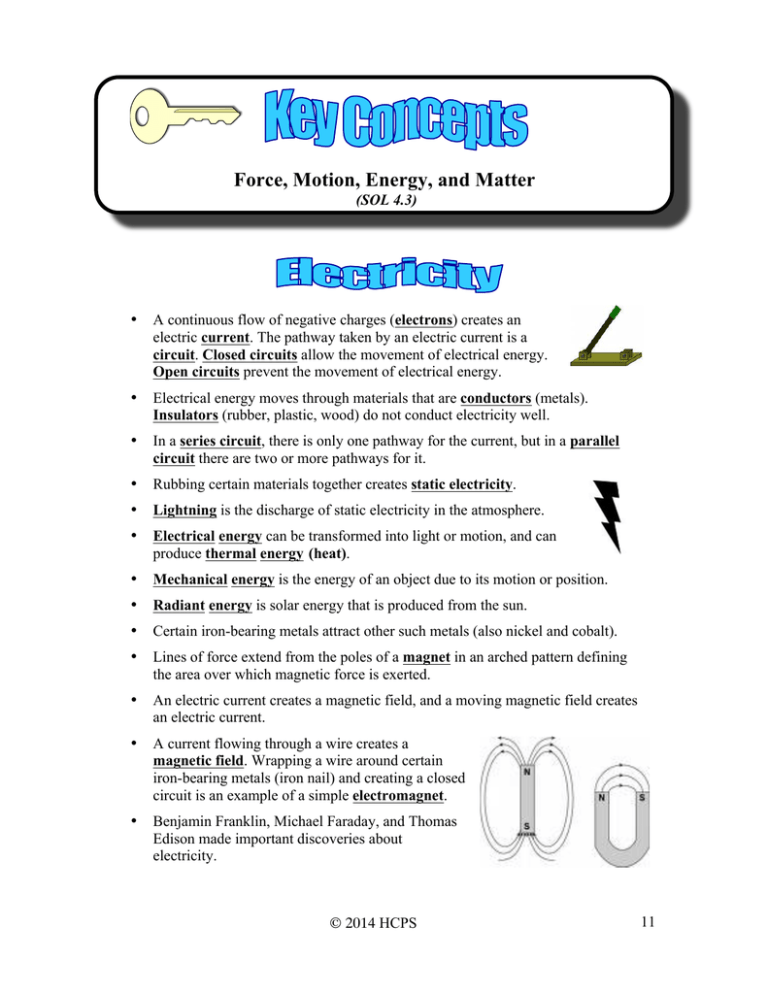
Force, Motion, Energy, and Matter (SOL 4.3) • A continuous flow of negative charges (electrons) creates an electric current. The pathway taken by an electric current is a circuit. Closed circuits allow the movement of electrical energy. Open circuits prevent the movement of electrical energy. • Electrical energy moves through materials that are conductors (metals). Insulators (rubber, plastic, wood) do not conduct electricity well. • In a series circuit, there is only one pathway for the current, but in a parallel circuit there are two or more pathways for it. • Rubbing certain materials together creates static electricity. • Lightning is the discharge of static electricity in the atmosphere. • Electrical energy can be transformed into light or motion, and can produce thermal energy (heat). • Mechanical energy is the energy of an object due to its motion or position. • Radiant energy is solar energy that is produced from the sun. • Certain iron-bearing metals attract other such metals (also nickel and cobalt). • Lines of force extend from the poles of a magnet in an arched pattern defining the area over which magnetic force is exerted. • An electric current creates a magnetic field, and a moving magnetic field creates an electric current. • A current flowing through a wire creates a magnetic field. Wrapping a wire around certain iron-bearing metals (iron nail) and creating a closed circuit is an example of a simple electromagnet. • Benjamin Franklin, Michael Faraday, and Thomas Edison made important discoveries about electricity. 2014 HCPS 11 When you turn on a machine that uses electricity, the current flows on a closed path called a circuit. The path is closed because the current flows around and around the path. A circuit can have any shape and any size as long as it is closed. A closed circuit allows the movement of electrical energy. Electrical energy can be transformed into light or motion or can produce thermal energy (heat). Circuits have to include a source of energy, such as a dry cell. Dry cells give the energy needed to get the current flowing. In a flashlight, the current moves from the dry cell to the light bulb and back to the dry cell. When you turn the switch off, the circuit is broken and the current stops flowing. The light goes out! This is called an open circuit, which prevents the movement of electrical energy. Parallel Circuit A parallel circuit allows the current to flow along more than one path. Each light has its own path – or “little circuit” – for electricity. When one of the lights in a parallel circuit burns out, the current then takes another path around the circuit. Meanwhile, the other lights stay lit. Electric appliances in your home are on parallel circuits. Series Circuit The current in a series circuit can move along only one path. If one light in a series circuit burns out, the circuit opens, and the other lights in the circuit will not light. 2014 HCPS 12 These iron filings show how the poles are the strongest part of a magnet. These iron filings show the magnetic field. Certain iron-bearing metals attract other iron-bearing metals. Permanent magnet • • A magnet that does not need electricity to attract other iron-bearing metals Example: A magnet you put on your refrigerator Electromagnet • A magnet made by passing an electric current through a wire wrapped around an iron rod (iron nail) The region of magnetic force around a magnet is called the magnetic field of a magnet. An electric current creates a magnetic field, and a moving magnetic field creates an electric current. If you place a compass near a live electric wire, the needle of the compass will move because the electrons in the wire create a magnetic field. A generator rotates a coil of wire through a magnetic field to create an electric current. Direction of current South Pole North Pole 2014 HCPS 13 Benjamin Franklin Benjamin Franklin was a respected statesman and scientist. His scientific experiments proved that lightning is a form of electricity. Franklin also helped develop the lightning rod, a device used to protect buildings from damage during electrical storms. Thomas Alva Edison Thomas Edison invented the incandescent light and the phonograph. He made improvements to the telephone, typewriter, electric generator, and electrically powered train. He designed the world’s first electric power stations, thereby making electric power available to millions. Michael Faraday Michael Faraday was a British physicist and chemist who discovered the principle of electromagnetic induction in 1831. He found that moving a magnet through a coil of copper wire caused an electric current to flow in the wire (induction). The electric generator and electric motor are based on this principle. 2014 HCPS 14 Directions: Label the following objects as an insulator or conductor of electricity. 1. copper wire ____________________ 2. rubber band ____________________ 3. gold ring ____________________ 4. wooden bowl ____________________ 5. glass jar ____________________ 6. silver plate ____________________ 7. plastic comb ____________________ 8. aluminum can ___________________ 9. steel bar ____________________ Plastic is an insulator in a wire. Copper is a conductor in a wire. 2014 HCPS 15 Directions: Fill in the blanks using the word bank below. Some words may be used more than once. electrical open poles iron filings static magnetic electromagnet closed current mechanical parallel series radiant thermal 1. Electrical energy cannot flow in a(n) ____________________ circuit. 2. Magnets are strongest at the ____________________. 3. A(n) ____________________ circuit allows the movement of electrons. 4. Lighting is an example of naturally occurring ____________________ electricity. 5. An electric current creates a ____________________ field, and a moving magnetic field creates an electric____________________. 6. Pedaling a bike causes the wheels to turn which is an example of _________________ energy. 7. ________________energy comes from the motion of tiny particles in matter. The faster the particles move, the warmer the matter can get. 8. An electric drill transforms electrical energy into ____________________ energy. 9. Current in a(n) ____________________ circuit can move along only one path. 10. A toaster uses ____________________ energy to produce heat energy. 11. ____________________ can show the magnetic field around a magnet. 12. A(n) ____________________ is made by passing an electric current through a wire wrapped around an iron rod. 13. ______________energy is solar energy. 14. Classrooms have ____________________ circuits, so that if one light burns out the other lights stay lit. 2014 HCPS 16
